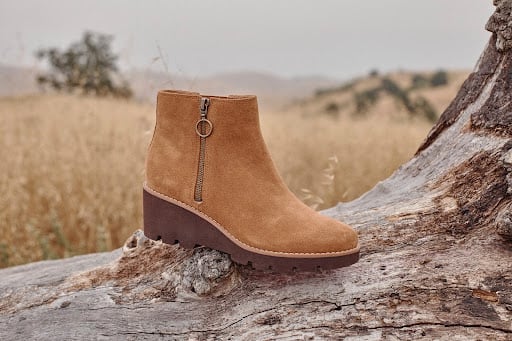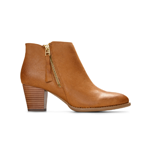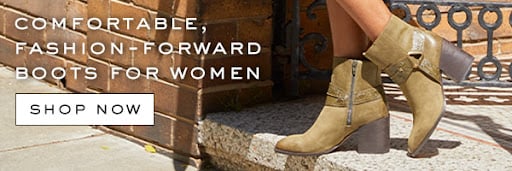
The Role of the Boot Shaft: Understanding its Impact on Style and Function
<
Shopping to find the perfect pair of boots can often feel like a Herculean quest.
You wade through a sea of footwear, and finally, there it is: the boot that checks all your boxes in terms of size and style. You eagerly slip a boot on, only to be confronted by an unpleasant truth—they simply don’t sit comfortably on your calves or ankles.
The reason why this narrative might sound familiar is that many people embark on their boot-shopping journey without a proper education in boot anatomy. While factors like length and width are commonly taught, what about the boot shaft? It’s often overlooked, yet it is a structurally and stylistically significant component of any boot.
Knowing the role, importance, and specifics of how to measure boot shafts ensures that you find a pair of women’s boots that looks stylish, feels comfortable, and provides the structural support you need.
What Is a Boot Shaft?
Grab the nearest pair of boots to you and hold them up to the light.
The part of the boot that begins at the base, covers the ankle, and then ascends up the leg—that’s the boot shaft. In simple terms, it refers to the cylindrical piece of the boot that starts at the base of the heel and rises upward to encircle your calf muscles.
The shaft is sometimes referred to as “the upper.” As Texas Monthly notes:1 “The upper typically features the boot’s pulls, sometimes called ears, and a scallop, which is the V-shaped dip at the front and back of the shaft. Most often, this part of the boot starts in two pieces, a front and a back, that are joined at the sides at a seam that might feature subtly decorative piping.”
Naturally, the shaft can vary in length, sometimes ending just above the ankle, other times reaching thigh-high. And such variations in boot shaft height aren’t solely aesthetic design choices, but rather, they can also impact the boot’s feel, function, and use.
Purpose of the Boot Shaft
On the surface, it may seem like the boot shaft is a relatively simple component. But, in reality, they’re the unsung hero. The shaft plays an essential role in a boot’s overall performance and appeal, and can have a significant impact on the following:
- Protection – The primary purpose of the boot shaft is to provide a protective shield for the legs. Cowboy boots, for example, cover the calves to shield the wearer from brush, thorns, and other hazards encountered while riding or working in rugged terrain. Similarly, work boots with taller shafts protect the feet and lower legs from both debris and hazards in industrial or construction settings.
- Support – Similarly, the boot shaft contributes to the overall structural support and stability of the foot and ankle. A well-designed shaft provides the necessary rigidity to prevent excessive movement, give, or twisting that could result in foot injuries or cause a person to lose their footing. This is especially important for activities or occupations where ankle support is essential for navigating loose, uneven terrain.
- Silhouette – The boot shaft is what gives a pair of boots their silhouette. It shapes the boot’s entire profile, influencing its overall appearance and style. The height, circumference, and design of the shaft contribute to the silhouette and can dramatically alter the boot’s look.
- Style – Seeing as the shaft may account for a significant percentage of the entire piece of footwear, the shaft’s length, design, and materials will all impact the style. Whether you’re going for modern chic or rugged western, the boot shaft will influence the formality, accents and closures, materials, and design details.
- Comfort levels – As mentioned, the boot shaft will also impact the long-term comfort of the wearer. This may spark the question of how should boots fit? A properly sized and fitted boot shaft should provide a proper fit in the calves and ankles without rubbing, causing discomfort, or allowing too much give. The shaft’s design, materials, flexibility, and sizes will impact how the boot conforms to the wearer’s feet, ankles, and calves.
Types of Boot Shafts
When it comes to the boot shaft, one size does not fit all. Various factors impact the types of boot shafts and styles, particularly in terms of length, design, and materials.
Length
Boot shaft size is the most significant determining factor in the type of boot. Here are some examples to demonstrate:
| Type of Boot | Height Range | Coverage | Examples | Occasion/Use |
| Ankle Boots | 3’’ to 8 ¾’’ tall | Only cover ankle | Chelsea boots, Desert boots, Booties, Dress boots, Chukkas | Casual wear, Everyday use, Fashion, Heavy-Duty Work |
| Mid-Calf Boots | 9’’ to 13 ½’’ tall | Halfway between ankle and knee | Cowboy boots, Biker boots, Moto boots, Steel toe work boots | Western-inspired, Casual wear, Outdoor, Heavy-Duty Work |
| Tall Boots | 13 ¾’’ to 17 ¾’’ tall | Nearly to the knees without covering them | Equestrian boots, Cowboy boots, Wallington boots, PVC boots | Formal, Equestrian, Dressy, Fashion, Heavy-Duty Work |
| Over-the-Knee Boots | 18’’ tall or taller | Higher than the knees | Thigh-high boots, Over-the-knee heeled boots | Statement, Night out, Fashion, Dressy |
Design
When it comes to the design of boot shafts, there are countless variations available. If you care more about function than design, there are minimalist boot shafts available for practically every length.
On the flip side, there are a dozen different design elements that can come into play—laced-up shafts, zipper designs, buckle and stud embellishments, unique colors, or exotic patterns, and so on. Even the most rugged pair of cowboy boots may have Western-inspired design elements on the boot shaft, such as:
- Harness straps
- Perforations or brogueing
- Fringe
- Cutouts
- Studs
- Rivets
- Decorative overlays
- Intricate stitching
Materials
Finally, a boot shaft can come in a variety of materials. Each one can uniquely contribute to the overall look, feel, and durability of any given boot. Common materials include:2
- Leather – A timeless choice, authentic leather boots are known for their stylish factor, durability, and ability to mold to the contours of the wearer’s foot over time. Leather shafts can come in various finishes, such as smooth, distressed, or embossed. As this material is a popular choice, be sure to refresh your knowledge on not only how to clean leather boots, but also how to break in leather boots if interested in adding a pair to your collection.
- Suede – Suede, a formal type of leather with a napped finish, can give the boot shafts a soft, velvety texture that’s ideal for a night out on the town, but ill-suited for the country or a jobsite. Similar to leather boots, suede requires the proper amount of care to maintain its look and feel so be sure to get yourself up to speed on the basics of suede boot care upon purchasing.
- Synthetic materials – Nylon, PVC, and faux leather are some of the cheaper alternatives to genuine leather, providing durability, water resistance, and versatility for a wide range of boot styles.
- Rubber – Most commonly used for rain boots or work PVC boots that need to be waterproof, rubber shafts afford excellent moisture protection.
- Textile fabrics – Fabrics like denim, twill, or canvas may be used for casual or sporty lightweight boots.
- Nubuck – A superior top-grain cattle leather, nubuck has a similar texture to suede, but tends to be more durable and resistant to wear.
How to Measure Boot Shafts and Height
If you want to ensure that your boots fit as good as they look, then you need to know how to measure boot shaft height. Remember, for taller boots, you’ll need to account for both the ankle circumference (measured at the narrowest part of the boot) as well as the calf circumference (measured at the fullest part of the boot).
To properly measure and size the boot height and shaft, follow these steps:
- Gather your tools – In this case, you’ll only need three items. First, grab a flexible sewing measuring tape. Then, put on the type of socks you’d plan to wear with the boots. Finally, lay down the boots.
- Sit down – Sit in a chair with your feet flat to the floor.
- Measure your ankle circumference – Find the narrowest part of the ankle on your leg and measure it using the flexible tape measure to the nearest half-inch.
- Measure your calf circumference – Find the widest point of your calf and measure it using the flexible tape measure to the nearest half-inch.
- Measure the height – Start at the top of the boot’s arch—the point at which the sole attaches to the boot—then measure the distance from the arch to the collar.
Once you have noted the various measurements, look for boots with slightly larger ankle circumference and calf circumference. Taking the time to measure and then select a boot according to both the ankle and calf circumferences will guarantee a snug fit whether sitting, standing, or walking.
Vionic—Discover Your Next Pair of Stylish Boots
The boot shaft truly is the linchpin of the boot, holding sway over every aspect—style, structure, fit, you name it.
Once misunderstood and overlooked, you should now appreciate the boot shaft as a pivotal part of your footwear journey. Equipped with your newfound understanding of boot shafts, you’re primed to navigate the world of boots with a discerning eye.
At Vionic, we believe that every piece of footwear should perfectly fuse style, comfort, and fit. We offer an array of boots, with varying shaft heights and styles. Whether you’re looking for an Inessa Tall Boot, perfect for a night out on the town, or a Lani Lace-up Boot that’s both city chic and country cool—shop Vionic.
Sources:
- Texas Monthly. An Inside Look at the Making of a Great Cowboy Boot. https://www.texasmonthly.com/being-texan/craft-boots/
- Gentleman’s Gazette. Anatomy of a Dress Shoe. https://www.gentlemansgazette.com/anatomy-of-a-dress-shoe/










